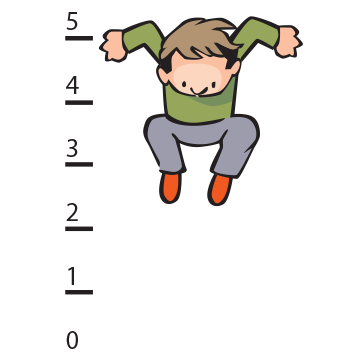Boston Children's Museum
308 Congress Street, Boston, MA 02210
617-426-6500
© Boston Children’s Museum 2025
Website Design by JackrabbitGravity is an important scientific concept, but one that is difficult to grasp, even for adults. Having children use their own bodies to test gravity, and then compare how they would fare against gravity on another celestial body provides a great jumping off point for understanding that the effects of gravity are different in different parts of our solar system.
Tape or stick two pages of the chart paper on the wall, one above the other so that they make one long sheet. The highest point of the top piece should be higher than any of your students can jump, and the bottom of the lower sheet should be no higher than your shortest student’s head. If you need a third sheet of paper to cover this range, you can of course use it. Alternatively, you can have students try a standing long jump, instead of jumping up. This requires no chart paper, but would work best with a roll of masking tape and a measuring tape for each team. NOTE: If you create only one jumping station, children will have to take turns, which might take some time. Plan for this, and think about what children can do as they wait for other children to jump. You might also consider creating two or three jumping stations in order to speed up the process, though this may require multiple staff, particularly if your children are younger.
If you have the prep time, you can place a long piece of tape alongside the paper and label it with inches or centimeters, from the floor to the top of the chart paper. This will help you quickly determine how high each student jumped in this activity, rather than having to measure after each jump.

Ask your students if they have ever heard of gravity before. Does anyone know how gravity affects us on Earth? Look for responses like “It’s what pulls you back down to Earth when you jump up.” Or “It’s what keeps us on the ground.”
Ask if anyone knows if the effect of gravity on the Moon is the same, stronger, or weaker than it is on Earth. After a few guesses, if you can, show them this NASA video of an astronaut jumping on the Moon (click here) and then have them guess again. After a few guesses (or, if you couldn’t show the video), tell them that the Moon’s gravity is weaker than the Earth’s – in fact it is 1/6th as strong as on Earth. When you’re on the Moon, you are 1/6th as heavy, but your muscles are as strong as they are on Earth, so you can jump 6 times farther.
See how high you can jump, and then calculate how high that jump would be on the Moon!
There are two versions of this activity, high jump and long jump. If you have time, try both!
High Jump Version:
Long Jump Version:
Ask your students if they were surprised by the results. Could anyone jump over their own head on the Moon, or farther than their own height? Who jumped the highest/farthest? What do they think it would be like to walk on the Moon? What would it be like to play basketball, soccer, or another sport? Reinforce the idea that the reason they can jump higher or farther on the Moon is because gravity is weaker there; and the reason that they can jump less high or far on Earth is because gravity is stronger.
If your students would like to, they can try again. You can also try the standing long jump, if you already did the high jump, and the high jump if you already did the long jump.
Another extension is to try the same activity for different bodies in our solar system. The activity is the same, but the calculations are different. Instead of multiplying by 6, use these numbers for other planets, moons, and the Sun:
Visit NASA’s solar system site at http://solarsystem.nasa.gov/planets for amazing images and information on each of these planets and moons, which you can share with your students.
And even better, visit this link for NASA videos of astronauts on the Moon, which you can download and watch over and over:
Earth and Space science activities were developed with the support of NASA. This material is based upon work supported by NASA under grant award number NNX14AQ83G. Any opinions, findings, and conclusions or recommendations expressed in this material are those of the author(s) and do not necessarily reflect the views of the National Aeronautics and Space Administration (NASA).